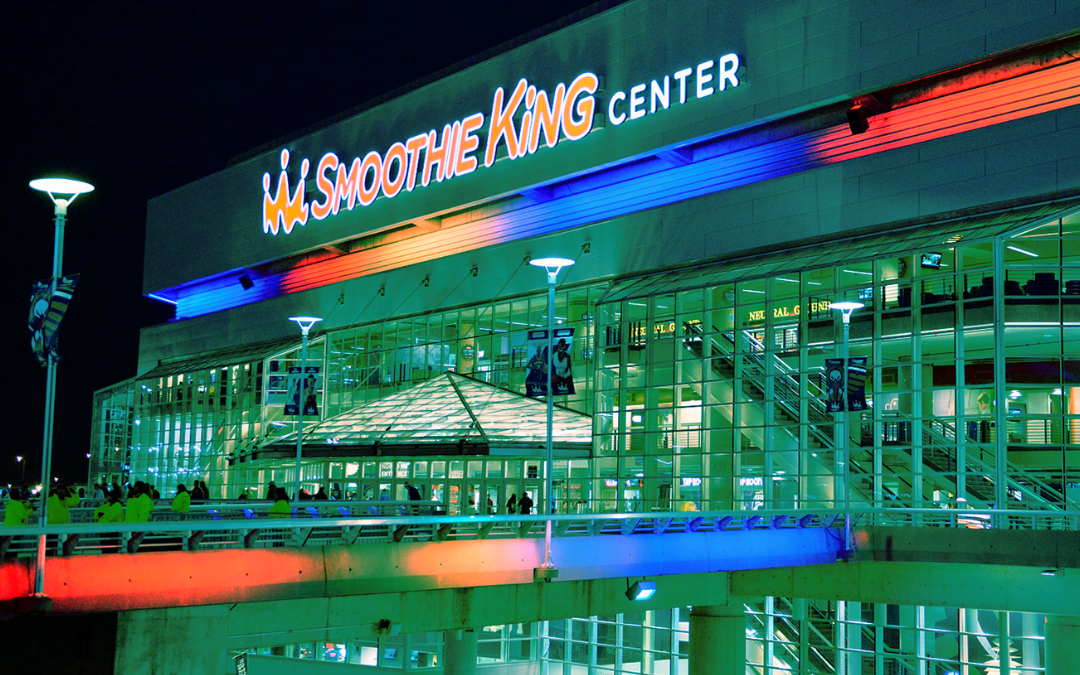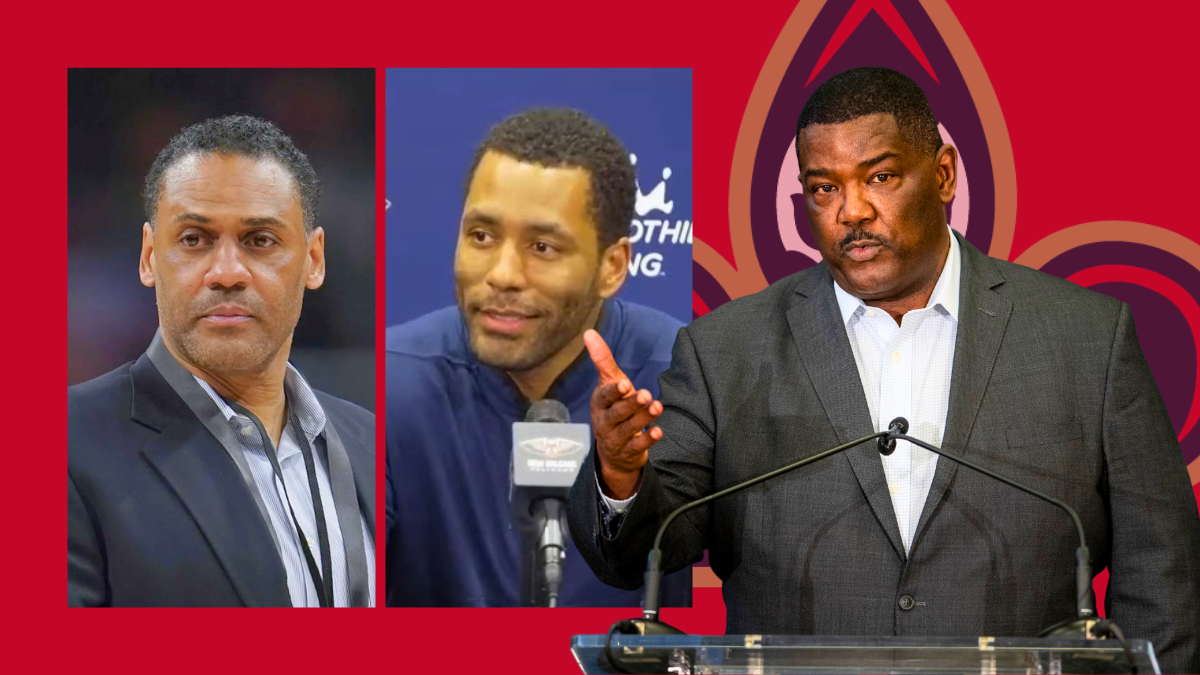Last week Christian Clark, Pelicans beat writer for the TIMES-PICAYUNE, reported that the franchise has no immediate plans to vacate its current home, the Smoothie King Center.
The Pelicans have a lease agreement that is set to expire next summer, however Clark quoted Pelicans SVP/Communications & Broadcasting who said the “intent is to exercise the option and shortly thereafter commission a study on Smoothie King Center’s short- and long-term viability with an eye to the future.”
That study would help determine whether or not the Smoothie King Center would be subject to an overhaul or replaced by a completely new facility.

Either way, it seems that a very expensive bill is about to come due.
The most recent arena to undergo a major makeover was Madison Square Garden. “The world’s most famous arena” was updated over the course of three years with a reported price tag of an estimated $1 billion.
That project was completed in 2013.
Now, just a decade later, there are already proposals to replace the building that opened at its current location in 1968. Cost estimates start at $5 billion and climb to as high as $8 billion.
The last two brand-new arenas to open were the Chase Center, home of the Golden State Warriors ($1.4B), and the Milwaukee Bucks’ home building, Fiserv Forum ($524M).
While both teams have won championships in their palatial new digs, just how much the cities have benefited from their investments is in dispute.
During the Bucks’ championship run generated approximately $3 million in tax revenue, according to a report from Milwaukee Magazine. However, the city received none of the money, as it was funneled back to the district that operates the area around Fiserv Forum, and the county took in less than $200,000.
Compare that to the Chase Center, a facility that was completely privately funded and it enabled the Warriors to bring all of their basketball operations under one roof. The city and state both soundly rejected any prospects of public financing for the arena. Still, the Warriors came up with the money to build an entire entertainment, business, and retail district with their own money.
The Warriors’ plan would certainly be the better option for residents of the greater New Orleans Metro Area. Though the city has a $1.5 billion budget, essential services, infrastructure, affordable housing, and law enforcement are all dealing with their own financial crises.
The state is currently on the hook for its $90 million contribution to the multi-year renovation of the Caesars Superdome; part of an estimated total cost of $450 million. The Saints are chipping in 1/3 of the bill with $150 million.
Those upgrades are expected to be competed some time this year.
A scenario where Gayle Benson and the Pelicans don’t push for significant upgrades to the Smoothie King Center seems highly unlikely.
NBA Commissioner Adam Silver, just like his other counterparts across professional sports, is constantly beating the drum for newer, bigger, and better arenas.
But should the state of Louisiana and the people of New Orleans foot the bill?
Politicians, league, and team executives will say “yes.”
History (and most economists) says “no.”
“If you ever had a consensus in economics, this would be it,” says Michael Leeds, a sports economist at Temple University. “There is no impact.”
There have been studies dating as far back to the 1990s, when baseball began to experience its own “building boom,” that have determined that in most cases, “building a stadium is good for the local economy only if a stadium is the most productive way to make capital investments and use its workers.”
The jobs that are typically promised as part of arena construction are limited, low-wage, and primarily temporary. The economic activity that surrounds the business that pop up around stadiums typically moves money from one area of the city to another, rather than generating any new income.
In 2003, the Los Angeles City Controller found that economic activity in Inglewood, Calif. actually increased once the Lakers left the Great Western Forum for the then-Staples Center. The city saw a steady rise in sales tax revenue.
Even the cost of major events can become a burden on taxpayers and an inconvenience for residents.
The thought of their favorite team leaving their city comes to forefront for fans anytime stadium financing is the topic.
But the economic realities have to be priority number one, especially for one of the smallest markets in the NBA and one of the poorest states in the nation.
The value of the New Orleans Pelicans has risen by 373% since the Benson’s purchased the team for $338M in 2012.
Benson’s net worth has been estimated at $4.7 billion. The Saints already have one of the most favorable lease agreements in the NFL, earning them at least $31 million annually. The Pelicans get an additional $3.65 million each year in rebates, more than any other company in the state.
Access to funds has never been an issue for the wealthy, and it is a tremendous issue for the people of Louisiana.
If the Smoothie King Center needs renovations, so be it. However, if the New Orleans Pelicans want to truly be partners with the city and state, they need to assume the lion’s share of those costs.
For more Pelicans talk, subscribe to The Bird Calls podcast feed on iTunes, Spotify, Stitcher or Google Podcasts. You can follow this author on Twitter at @DMGrubb.
READ MORE
- Carmelo Anthony’s Crescent City Connections
- With One Month Until The NBA Draft Pelicans Have Decisions To Make
- Pelicans Will Return To Birmingham During 2023 Preseason
- NBA Draft: Even Without Wembanyama, Pelicans Can Add To Their Solid Core
- NBA Draft Lottery: New Orleans Pelicans seek to overcome odds like Charlotte Hornets
- Building A Wall: Pelicans Must Find A Way To Protect The Paint





Build a new arena by the river and make it the best in the league. Plus a new training facility in close proximity.
Not if the city/state have to pay the costs. It makes no sense economically. It’s irresponsible for the public to take on that cost.
On the river would be an amazing experience. The city needs to be more innovative and take advantage of that open property with putting something spectacular there like Golden State new Arena
Golden State’s owner paid the cost for that though.
Curious what was the cost? So Gayle Benson is not willing to pay for the entire cost? It’s not like she won’t make that money back right?
The Warriors paid $1.4 billion of their own money to build the entertainment district where the arena is located. San Francisco flat out refused to contribute a dime. The Warriors financed the deal themselves, which makes plenty of sense, since they do have the working capital to get any loan they want at a very reasonable rate. And they get to reap the profits of the other businesses they developed in the area. It’s private business and again, there is not a single economist who will tell you that public financing of stadiums benefits the people.
“The Golden State Warriors obtained the land from Salesforce CEO Marc Benioff to construct their state-of-the-art stadium, and the team’s investors include some of the biggest names in tech. Before the arena’s opening, the team had already brought in $2 billion from the sale of tickets, suites, and corporate sponsorship. The Warriors will also see revenue generated from office space, which is set to be filled by the ride-hailing giant Uber.”
If you want the Pels to leave, then insist Mrs. B foot the entire bill. If you want them to stay, work out a deal with the City and the State, with her chipping in a fair share.